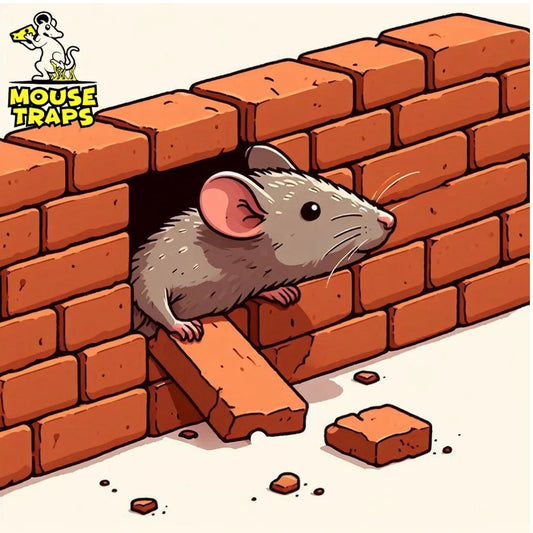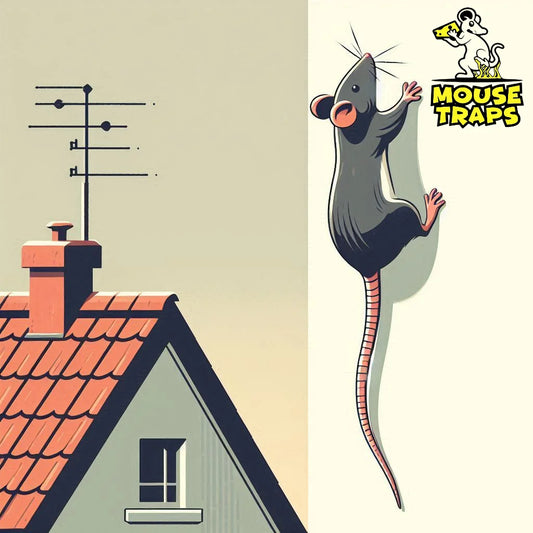Introduction:
Rats are notorious pests that can cause damage to property and pose health risks to humans. One of the most common ways they gain access to homes is through gaps in brickwork or foundations. Thankfully by taking the precautions you can deter these guests. This article offers a guide to assist you in keeping rats from gaining access, to your home, via brickwork or foundations.
Steps To Prevent Rats From Entering Through Gaps In Brickwork Or Foundations:
1. Inspect Your Property:
Start by inspecting the outside of your house focusing on spots where the bricks touch the ground or where the foundation meets the walls. Check for any spaces, fractures or gaps that might be used as entryways, by rats. These can be as small as half an inch in diameter, as rats can squeeze through surprisingly tight spaces.

2. Seal Entry Points:
Once you've identified potential entry points, gather appropriate materials for sealing them off. Steel wool, wire mesh, and concrete are effective options. Ensure that any gaps or cracks are completely filled and sealed. Make sure to focus on spots, near pipes, vents and utility lines since these are spots where rodents can get in.

3. Repair Damaged Brickwork:
Inspect your brickwork for any signs of damage, such as loose bricks or crumbling mortar. Use mortar or concrete to repair any damaged areas, making sure to create a smooth and solid surface that rats cannot easily penetrate.
4. Trim Vegetation:
Keep plants and vegetation trimmed at least several feet away from the exterior of your home. This not only eliminates potential hiding spots for rats but also reduces the likelihood of them using branches or vines to access your roof or upper levels. Pay particular attention to trees that overhang your roof, as these can provide easy access for rats to climb onto your home.

5. Secure Garbage Bins:
Use tightly sealed garbage bins to prevent rats from accessing food waste. Consider investing in bins with locking lids or adding additional security measures, such as bungee cords, to ensure that lids remain securely closed. Regularly clean and sanitize your garbage bins to remove any lingering odors that could attract rodents.

6. Eliminate Food Sources:
Store food in airtight containers made of materials that rats cannot chew through, such as glass or metal. Clean up spills and crumbs promptly, especially in areas like kitchens, pantries, and dining areas. Avoid leaving pet food outdoors, and if you must feed pets outside, remove any uneaten food promptly.
7. Remove Clutter:
Clear away clutter from around the exterior of your home, including piles of debris, woodpiles, and unused equipment. Keeping your surroundings neat and organized can discourage rats, from setting up their hiding spots and nests as they are drawn to spaces.

8. Install Rat Guards:
Install metal rat guards or barriers around pipes and utility lines where they enter your home. These guards are, in place to stop rats from scaling up and entering your property through these pathways. Make sure that rat guards are securely fastened and cover the entire length of the pipe or utility line to be effective.

9. Use Traps or Baits:
Set up rat traps or bait stations strategically around the exterior of your home, focusing on areas where you've observed rat activity or near potential entry points. Choose traps or baits that are appropriate for outdoor use and follow the manufacturer's instructions carefully for placement and safety.
Live Humane Mouse Traps:
Live humane mouse traps are designed to capture mice without harming them, allowing you to release them back into the wild away from your home. Here are some details and benefits of using live humane mouse traps to deal with rodents entering through gaps in brickwork or foundations in the UK:

Benefits:
- Humanitarian Approach: Live humane mouse traps offer a compassionate solution for dealing with rodent problems without resorting to lethal methods.
- Environmentally Friendly: By capturing mice alive and releasing them back into the wild, you avoid the use of toxic chemicals or poisons that could harm other wildlife or pets.
- Legal Compliance: In the UK, there are regulations governing the humane treatment of animals, including rodents. Using traps for mice can assist in meeting regulations and controlling mouse issues effectively.
- Safe for Use Indoors: Unlike traditional snap traps or rodenticides, live humane mouse traps are safe for use indoors, making them suitable for dealing with mice that have entered your home through gaps in brickwork or foundations.
- Easy to Use: Live humane mouse traps are simple to set up and use, requiring minimal maintenance. Once a mouse is captured, you can release it quickly and easily without having to handle the rodent directly.
Sticky Glue Mouse Pads:
Sticky glue mouse pads, also known as glue traps, are another option for capturing mice without using lethal force. Here are some details and benefits of using sticky glue mouse pads to deal with rodents entering through gaps in brickwork or foundations in the UK:

Benefits:
- Non-Toxic: Sticky glue mouse pads do not contain any toxic chemicals or poisons, making them safe for use in homes with children or pets.
- Low Cost: Glue traps are relatively inexpensive compared to other rodent control methods, making them a cost-effective solution for managing mouse infestations.
- Easy to Dispose Of: Once a mouse is trapped on a sticky glue pad, you can simply dispose of the pad in the trash, making cleanup quick and hassle-free.
- Effective: Glue traps are highly effective at capturing mice, providing a reliable method for controlling rodent populations in homes and buildings.
- Versatile: Sticky glue mouse pads can be placed in various locations around your home, making them suitable for targeting mice that enter through gaps in brickwork or foundations.
10. Monitor Regularly:
Make it a habit to periodically inspect the exterior of your home for new signs of rat activity or potential entry points. Watch out for signs, like bite marks, rat droppings, footprints and damage, from gnawing. These could signal rats trying to enter your property. By staying alert and dealing with problems quickly you can stop small rat issues from turning into infestations.

Conclusion:
By following these comprehensive steps, you can effectively prevent rats from entering your home through gaps in brickwork or foundations. Make sure you're thorough, in checking your property for any signs of rodents. By being persistent and paying attention to details you can ensure your home stays free of rats protecting both your property and health.




